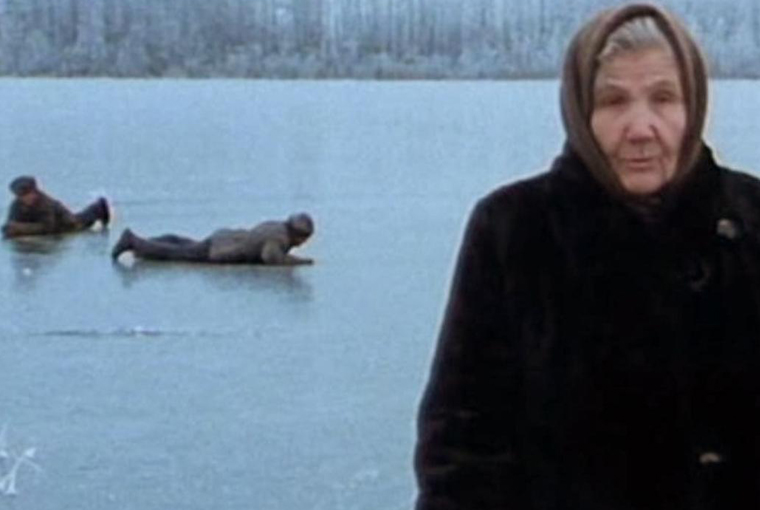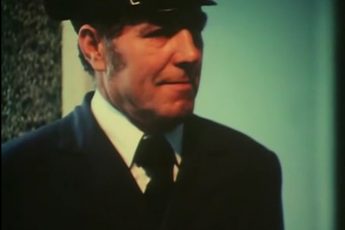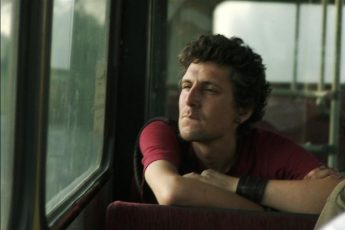Werner Herzog and Russia’s Ecstatic Truth
Some Comments on Bells from the Deep: Faith and Superstition in Russia (1993)
Vol. 27 (March 2013) by Pau Bosch Santos
Werner Herzog is a declared enemy of Cinéma Vérité. “Filmmakers of Cinéma Vérité,” he wrote in his Minnesota Declaration (1999), “resemble tourists who take pictures amid ancient ruins of facts.” They conflate facts with truth. Whereas Herzog himself has repeatedly claimed all along his career that his main concerns are “the innermost landscapes of human beings.”1 On his view, filmmaking should be more similar to poetry than history. The filmmaker should not state what Herzog calls the accountant’s truth, which depicts external landscapes just for the sake of landscapes themselves, for the sake of facts and reality, of ethnography and historical memory. Of course the filmmaker should be moved by a sense of justice or responsibility towards reality. But, more importantly, he should show how this apparently exterior landscape is actually more accurately seen as a reflection of an inner landscape. He should make patent how, why, or at least that, he projected his own and/or someone else’s self into that landscape. And also how, without the least disrespect towards reality and facts themselves, he could, by playing with them and manipulating them, shed some extra light onto these facts and onto his own and/or someone else’s destiny, thereby illuminating some long-lived darkness of the human soul. Such is the natural gift he was accorded and therefore his prophetic mission: “I know that I have the ability to articulate images that sit deeply inside of us, that I can make them visible.”2
Whether such a mission and the aspirations it carries are really desirable and fall within the filmmaker’s grasp or are sheer crap springing out of some stone-age mystic’s hangover-like dreams is left to the reader’s good sense to decide. But it is this reviewer’s guess that few will deny, at least to some extent, a certain delicacy and fortune in Herzog’s treatment of landscapes and of images in general and, at its most, some moments of, as the German filmmaker is fond of saying, deep insight and ecstatic truth (a conjunction of words that this reviewer tends to interpret as meaning something along these lines: “Images of such a raw and savage beauty, and of such a febrile and ruthless voraciousness, that one can’t help but staring at the screen with eyes and mouth wide open marveled and terrified at once at the cosmos’ existence.” Now, how to interpret the expressions ‘raw and savage beauty’ and ‘febrile and ruthless voraciousness’ is anybody’s guess).
Whatever the case, this has been Herzog’s main pursuit. His films first and foremost present his own, stylized vision of things. But then one should also bear in mind that while Herzog is absolutely unrelenting in his quest and will do everything in his power to realize his visions, he neither seems to take himself nor life in general too seriously. And this ironic, almost clownish side of his counterbalances his other heavy-duty side.3
Herzog has thus earned the reputation of being not just a megalomaniac that will step over anything or anybody that crosses his path, deforesting a whole Amazonian slope in order to have a handful of Indians pull up a steamboat or threatening to put five bullets in your back before you reach the next river bent if you dare leave the set before the film’s last take, but also a blatant liar and forger, who falsifies filming licenses with the signatures of Peru’s or Burma’s Presidents or may insert Pascalian pseudo-quotes at the onset of his documentaries to transport you beyond the realm of mere reportage from the very beginning. Bells from the Deep will in all probability be remembered (if remembered at all) as the film for which Herzog hired a couple of drunkards from some nearby town to stand in for pilgrims crawling on the thin layered ice of Lake Svetloyar seeking a vision of the sunken city of Kitezh, one of them so drunk that he actually fell asleep with his face stuck to the ice, thus giving the impression of being in profound meditation. (This is in fact the only anecdote this reviewer has repeatedly read all over the scarce literature concerning the film). But when asked whether this kind of filmmaking can be regarded as cheating, Herzog replies:
Bells from the Deep is one of the most pronounced examples of what I mean when I say that only through invention and fabrication and staging can you reach a more intense level of truth that cannot otherwise be found. I took a ‘fact’ – that for many people this lake was the final resting place of the lost city – and played with the ‘truth’ of the situation to reach a more poetic understanding.
And a bit further:
In a way, the scene of the drunken city-seekers is the deepest truth you can have about Russia because the soul of the entire country is somehow secretly in search of the lost city of Kitezh. I think the scene explains the fate and soul of Russia more than anything else, and those who know about Russia best, Russians themselves, think this sequence is the best one in the whole film. Even when I tell them it was not pilgrims out there on the ice, it was people whom I hired, they still love it, and understand the scene has captured some kind of ecstatic truth.4
Now this is a blunt statement as to the licenses granted to him by the faith he has in his own visionary condition, something people might not necessarily be happy with (as was maybe the case when he was shot with an airsoft gun while being interviewed in L.A.?). But the fact that he takes this kind of licenses, as well as the fact that what Herzog is trying to depict is an inner landscape, are not restraint to Bells from the Deep. These facts are actually the common denominator of every single film he’s shot, and one only feels compelled to point them out here because they are the two basic premises anyone confronted with any of Herzog’s films should be aware of. What this reviewer finds most remarkable about Bells is rather a) that it is one of the few Herzog films not centered on one main character, and, what is more, as far as this reviewer knows, the only one in which the inner landscape attempted to depict is that of a whole country, and b) that the way in which the film depicts the Russian soul is an utterly non-narrative one (more on that infra). Both of these features are also linked to the film’s subject, which is, as its subtitle says, Faith and Superstition in Russia.
So the first thing anyone minimally familiar with Herzog’s movies is struck by when watching Bells is that, like Fata Morgana, Ballad of the Little Soldier, Wodaabe, Lessons of Darkness, Wheel of Time, Encounters at the End of the World or The Cave of Forgotten Dreams, the film is not about any particular individual, but instead about a bunch of them and, above all, about some (non-geographical) place. Unlike any of these films, Bells has the confessed ambition to “depict the soul of an entire nation.”5 Ironically though, individuality wise, the nation we are talking about here had made it a matter of State, from 1917 till 1989, to wipe out every form of individuality. Think about a radically free and anti-social soul like Timothy Treadwell a.k.a. Grizzly Man: had he been in the steppes of Russia and not in Alaska during those days, he would have been more likely to end up in a Gulag than in the stomach of a bear. Now the motivations for a sociopath like Treadwell to try and escape from society are somewhat similar to those leading a whole country like Russia to segregate from the rest of the world, and to impose its own sort of ascetic way of life on mass scale. It takes a good deal of faith to behave in such a way. But it was precisely, and somewhat paradoxically, the old faith and traditions of Russia that the Soviet regime was more painstakingly fighting against. It is therefore hard not to think, even for someone not familiar with Herzog’s tastes and obsessions, that the take-home message of such a film, released four years after the fall of the Berlin Wall, would be that such irrational features as faith and superstition are the underlying forces that glue together (and perhaps ultimately make possible?) such a seemingly and professedly rational state as one demanding the sacrifice of the individual’s well-being to an abstract, common good.
But then another thing that strikes the spectator is the way in which such a picture is brought forward. We’re left on our own, helpless, before a sequence or bundle of scenes devoid of any narrative whatsoever. Herzog doesn’t speak, except to dub the Russian. And the intertitles that introduce us (when they do) to the different characters, places or rituals act more as a breach than as a link between them. Rather, characters, places and rituals form a sort of mosaic or collage. A mosaic in which some of the characters or places are endowed with great salience, whereas most of the others appear only once, sometimes in sequences less than five minutes long. And still some characters and places reappear. Thus the film opens with an image of the two drunken pilgrims creeping around the frozen lake, but we’ll not know who they are (or who they are supposed to be) until later, as the legends and miracles surrounding the city of Kitezh and its pilgrims only come on stage during the second half of the film. And this guy, Vissarion – a former policeman who thinks of himself as a reincarnation of Christ and who, by then, was busy creating a still-lasting sect of eco-vegan ascetics –, together with some of his adherents, appears in a couple of scenes in the first half of the film explaining his love-thy-neighbor-and-Mother-Earth-as-thy-love-thyself doctrine, and then closes the film with a blessing for all and a slow-motion closing of hands that will stick to your memory. But there’s only a single take of the faith healer who teaches how to purify water before a theater that is full to the brim; or of the sorcerer who exorcises some women inside a high school gym; or of the exorcism of the evil spirits practiced by a shaman for a nomad family somewhere in the Taiga; or of the villagers of some town (we’re not told which) dividing up, in a market-like fashion, a bucket full of consecrated water; or of the orphan and bell-tolling artist Yuri Yurevitch Yurieff; or of some Mongolian throat singers… and so on and so forth. And something also worth remarking about the way the film’s made is that, although it clearly puts forward its constructive nature (i.e. the fact that it is a fabrication), and almost as if it was a parody of Cinéma Vérité, it (paradoxically, if you wish) at the same time gives the impression of being totally objective, non-interfering with the reality that it is exposing to our senses.
And so it would turn out that what Herzog considered as the ecstatic truth about Russia was this chaotic mosaic, or medley, in which it is almost impossible to tell the difference between true faith and mere superstition. Or, to say it better: that he thought that the best way to represent such a fuzzy border between faith and superstition was through such an apparently chaotic medley. And he also must have thought that the Russian soul was delivering itself so straightforwardly in such a mosaic that there was no need to add any commentaries whatsoever. What is more: precisely because he considered faith and superstition as the deep roots of the Russian soul and as the forces that have bound and continue to bind the nation together (these telluric forces constituting maybe the actual reason why Russia was to be the first place to seriously attempt the realization of the communist idea?), and because such forces fall by definition beyond reason, a narrative structure for the film had to be excluded, since imposing a narrative is imposing a form of order and therefore of reason.
Whether Herzog was reasoning this way while editing the film, well, one would have to ask the guy. But, regardless of the truth of this structural hypothesis, one has to admit that the film somehow conveys the very same vision of Russia that Russians have long held of themselves. Cf. for instance the words of the poet Tyutchev quoted by the Christian existentialist Berdyaev: “Russia is not to be understood by intellectual processes. You cannot take her measurements with a common yardstick, she has a form and a stature of her own: you can only believe in Russia.”6 Now again you may or may not think this mystical idea Russians have about a presumptive Russian soul is sheer crap. That’s not the point. It is a fact that they’ve long held it and that they continue to hold it (think e.g. about the new currents of nationalism that come under the label of Slavic Neopaganism, which started to flourish, curiously, one year after the film’s release). What Herzog did is what he does best: present us with a portrait of madness and obsession out of the utmost respect – not worshiping madness, not despising it, but treating it with the exact dose of humor that it deserves.




Leave a Comment